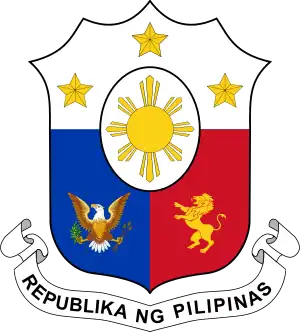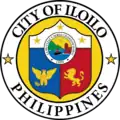 |
|---|
|
|
The legislative districts of Iloilo City are the representations of the highly urbanized city of Iloilo in the various national legislatures of the Philippines. The city is currently represented in the lower house of the Congress of the Philippines through its lone congressional district.
History
The territory of what is now Iloilo City initially formed part of the second district of Iloilo province in 1907. At the time of the passage of the Election Law (Act No. 1582) for the Philippine Legislature on January 9, 1907,[1] Arevalo was a separate municipality, while the municipality of Iloilo was, by virtue of Act No. 719 of April 3, 1903, composed of the territories of the Spanish-era pueblos of Iloilo, Jaro, La Paz, Mandurriao and Molo. Jaro once again became a separate municipality by virtue of Executive Order No. 64 issued on December 24, 1907, while La Paz was re-established in 1920 by virtue of Executive Order No. 70 signed on October 11, 1919.
When seats for the upper house of the Philippine Legislature were elected from territory-based districts between 1916 and 1935, the then-municipalities of Arevalo, Iloilo (also encompassing Mandurriao and Molo), Jaro and La Paz — along with the rest of Iloilo province — formed part of the seventh senatorial district which elected two out of the 24-member senate. When the City of Iloilo was created in 1936 by merging the municipalities of Arevalo, Iloilo and La Paz, the new city remained within the second district of Iloilo province. Jaro, also part of the second district, was annexed to the city later in 1940.
In the disruption caused by the Second World War, two delegates represented the chartered city (separately from the province) in the National Assembly of the Japanese-sponsored Second Philippine Republic: one was the city mayor (an ex officio member), while the other was elected through an assembly of KALIBAPI members within the city during the Japanese occupation of the Philippines. Upon the restoration of the Philippine Commonwealth in 1945, the city's representation reverted to the second district of Iloilo province, of which it remained a part until 1972.
Iloilo City was represented in the Interim Batasang Pambansa as part of Region VI from 1978 to 1984. The city, along with the rest of the province of Iloilo, elected five representatives, at large, to the Regular Batasang Pambansa in the 1984 elections.
Iloilo City was provided its own congressional district under the new Constitution[2] which was proclaimed on February 11, 1987. The new lone district elected members to the restored House of Representatives starting that same year.
Lone District
- Population (2015): 447,992
| Period | Representative |
|---|---|
| 8th Congress 1987–1992 |
Rafael J. Lopez-Vito |
| 9th Congress 1992–1995 | |
| 10th Congress 1995–1998 |
Raul M. Gonzalez |
| 11th Congress 1998–2001 | |
| 12th Congress 2001–2004 | |
| 13th Congress 2004–2007 |
Raul T. Gonzalez, Jr. |
| 14th Congress 2007–2010 | |
| 15th Congress 2010–2013 |
Jerry P. Treñas |
| 16th Congress 2013–2016 | |
| 17th Congress 2016–2019 | |
| 18th Congress 2019–2022 |
Julienne L. Baronda |
| 19th Congress 2022–2025 |
At-Large (defunct)
1943–1944
| Period | Representative |
|---|---|
| National Assembly 1943–1944 |
Fortunato R. Ybiernas[3] |
| Vicente R. Ybiernas (ex officio)[3] |
See also
References
- ↑ United States Department of War (1901). Acts of the Philippine Commission, No. 1-1800 - Volume X. Washington, D.C.: U.S. Government Printing Office.
- ↑ "1987 Constitution of the Philippines - Apportionment Ordinance". Retrieved June 13, 2016.
- 1 2 Official program of the inauguration of the Republic of the Philippines and the induction into office of His Excellency Jose P. Laurel. Bureau of Printing. 1943.
